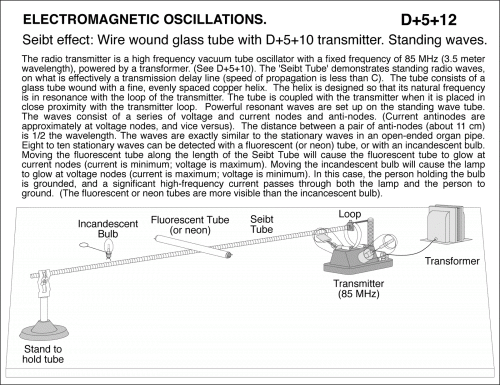Seibt effect: Wire wound glass tube with 510 transmitter.
Primary tabs
Seibt effect: Wire wound glass tube with D+5+10 transmitter. The radio transmitter is a high frequency vacuum tube oscillator with a fixed frequency of 85 MHz (3.5 meter wavelength), powered by a transformer. (See D+5+10). The 'Seibt Tube' demonstrates standing radio waves, on what is effectively a transmission delay line (speed of propagation is less than C). The tube consists of a glass tube wound with a fine, evenly spaced copper helix. The helix is designed so that its natural frequency is in resonance with the loop of the transmitter. The tube is coupled with the transmitter when it is placed in close proximity with the transmitter loop. Powerful resonant waves are set up on the standing wave tube. The waves consist of a series of voltage and current nodes and anti-nodes. (Current antinodes are approximately at voltage nodes, and vice versus). The distance between a pair of anti-nodes (about 11 cm) is 1/2 the wavelength. The waves are exactly similar to the stationary waves in an open-ended organ pipe. Eight to ten stationary waves can be detected with a fluorescent (or neon) tube, or with an incandescent bulb. Moving the fluorescent tube along the length of the Seibt Tube will cause the fluorescent tube to glow at current nodes (current is minimum; voltage is maximum). Moving the incandescent bulb will cause the lamp to glow at voltage nodes (current is maximum; voltage is minimum). In this case, the person holding the bulb is grounded, and a significant high-frequency current passes through both the lamp and the person to ground. (The fluorescent or neon tubes are more visible than the incancescent bulb). ELECTROMAGNETIC OSCILLATIONS
UCB Index:
D+5+12
UCB Taxonomy:
Popularity:
- Log in to post comments

